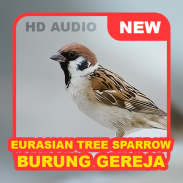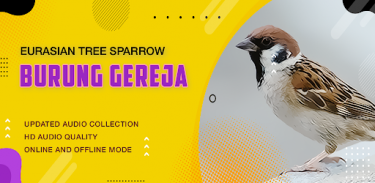








Bird
Eurasian Tree Sparrow

Description of Bird: Eurasian Tree Sparrow
The Eurasian tree sparrow (Passer montanus) is a passerine bird in the sparrow family with a rich chestnut crown and nape, and a black patch on each pure white cheek. The sexes are similarly plumaged, and young birds are a duller version of the adult. This sparrow breeds over most of temperate Eurasia and Southeast Asia, where it is known as the tree sparrow, and it has been introduced elsewhere including the United States, where it is known as the Eurasian tree sparrow or German sparrow to differentiate it from the native unrelated American tree sparrow. Although several subspecies are recognised, the appearance of this bird varies little across its extensive range.
Hear sparrow sounds that will help you recognize these common birds in your own backyard!
The Eurasian tree sparrow's untidy nest is built in a natural cavity, a hole in a building or the disused nest of a European magpie or white stork. The typical clutch is five or six eggs which hatch in under two weeks. This sparrow feeds mainly on seeds, but invertebrates are also consumed, particularly during the breeding season. As with other small birds, infection by parasites and diseases, and predation by birds of prey take their toll, and the typical life span is about two years.
Sparrows may be harder to spot than other birds, since their subtle brown feathers offer a bit of camouflage in their natural surroundings. However, once you learn sparrow sounds you'll be able to identify these birds without even seeing them! Sparrow songs are simple and consist of a series of 'cheep' notes. Makes are typically the ones who sing, using their voices to attract a mate. Female sparrows only occasionally use their song, also in hopes of attracting a new mating partner. In flocks, sparrows also use other calls to communicate, such as a single 'cheep' to indicate submissiveness. Females also make a chattering sound to chase off other females.
The Eurasian tree sparrow is widespread in the towns and cities of eastern Asia, but in Europe it is a bird of lightly wooded open countryside, with the house sparrow breeding in the more urban areas. The Eurasian tree sparrow's extensive range and large population ensure that it is not endangered globally, but there have been large declines in western European populations, in part due to changes in farming practices involving increased use of herbicides and loss of winter stubble fields. In eastern Asia and western Australia, this species is sometimes viewed as a pest, although it is also widely celebrated in oriental art.
While sparrows may not be as flashy as some brightly colored songbirds, these familiar birds often live in cities and neighborhoods, making them an important bird to recognize! Sparrows are small, plump, brown or grey birds that are highly social. They often live in large flocks and can be found nesting near or even in human houses! The sparrow is one of a few types of birds that practice dust bathing, a behavior where the sparrow digs a small hole then lays down and uses its wings to flick dust over its body.
Listen to the sparrow's simple yet beautiful song! Birdwatchers will delight in recognizing the sparrow by its voice alone!

























